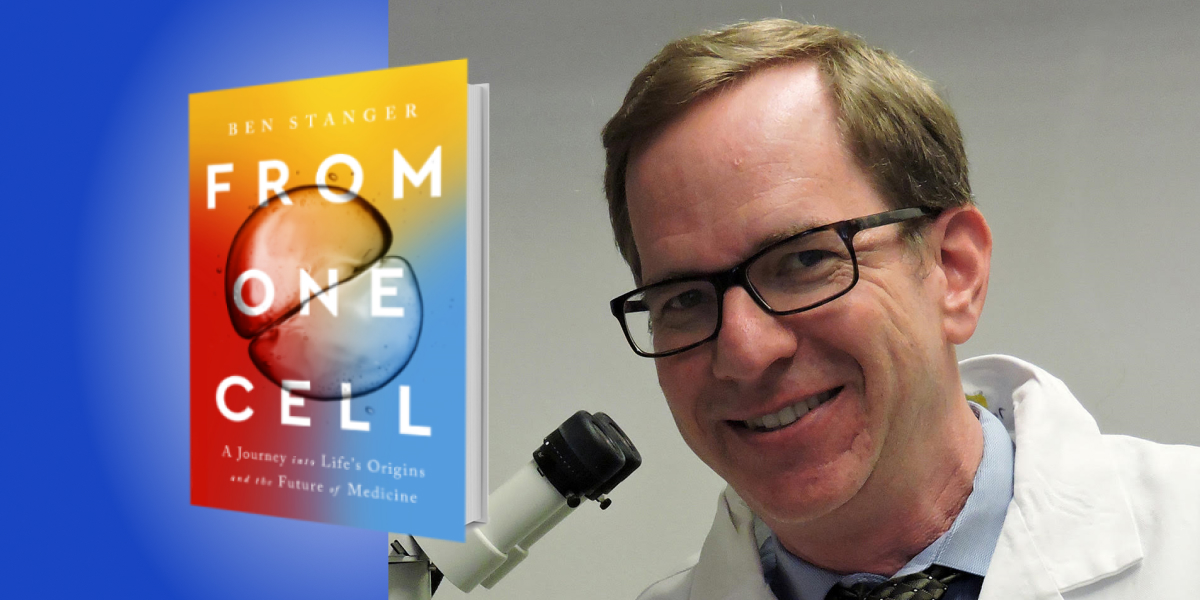Ben Stanger is a medical doctor, molecular biologist, and the Hanna Wise Professor in Cancer Research at the University of Pennsylvania. A graduate of MIT and Harvard Medical School, he has published over 150 scientific articles.
Below, Ben shares five key insights from his new book, From One Cell: A Journey into Life’s Origins and the Future of Medicine. Listen to the audio version—read by Ben himself—in the Next Big Idea App.

1. It is a miracle that any of us are here.
“Where do babies come from?” On the surface, this is a laughably simple question and one that you may have asked an adult when you were still a child. However, if we probe a little deeper, recognizing that all animal life begins as one cell, a solitary fertilized egg, then we start to see the implausibility of our very existence.
To give rise to the ten trillion cells in our bodies, that first cell does not simply divide (any bacterial cell can do that); rather, its cellular offspring need to “make decisions” as they grow, choosing what type of tissue or organ to become, and where to go in three-dimensional space. These measures give our bodies and brains their remarkable capacity to eat, breathe, sing, dance, love, and mourn. Each episode in development is carried out with precision, but the process leaves room for variation. This gives every one of us, even genetically identical twins, our unique and individual traits.
Despite its implausibility, billions of single cells embark on this journey every day across the animal world. All of this happens in the background, unseen, and yet every hour in embryo time brings change: structures take shape as new cells are born, stretch out, and start communicating with their neighbors. We know quite a bit about these steps, but our ignorance still dwarfs our understanding.
2. Chance is the secret sauce of science.
Think of a biological or medical question: How are memories stored? Or, how do we cure cancer? It is easy to imagine that if we throw sufficient resources at the problem, enough money and manpower, solutions will present themselves. After all, this thinking helped shape the world as we know it, a world filled with cell phones, electric cars, and the internet.
However, scientific discovery doesn’t work that way. Unlike the engineering feats above, whose end-products could be visualized at the outset; basic research involves traveling into the void, taking some observation that doesn’t fit our understanding of the world and running with it. This was the case for Thomas Hunt Morgan. While studying white-eyed flies, Morgan stumbled onto the realization that genes reside on chromosomes. Ernest (Bun) McCulloch, discovered stem cells by performing an autopsy on a mouse earlier than he was supposed to. Naturally, these scientists were open to investigating these anomalies that arrived at these new scientific truths, but it was serendipity that first led them there.
“Basic research involves traveling into the void, taking some observation that doesn’t fit our understanding of the world and running with it.”
Life events, subject as they are to chance, can also shape the path of discovery. John Gurdon discovered a way to reprogram a cell back to its earliest embryonic stages, a result that informed all stem cell work that followed. As a student, Gurdon had no interest in genes or cells; it was butterflies that fascinated him. He envisioned a career for himself as an entomologist, or, failing that, as a scholar of ancient Latin and Greek. However, fate threw one obstacle after another in his way, landing him somewhat unwillingly in a developmental biology lab, and the rest, as they say, is history.
3. Many Nobel Prizes in Medicine aren’t about medicine.
Alfred Nobel stipulates that the prize should be awarded to “the person who shall have made the most important discovery within the domain of physiology or medicine.” Yet if you scan the list of laureates over the past century, it is hard to find more than a handful that pertain directly to patients. Counterintuitively, the greatest impact has come from those discoveries that originally bore the weakest connections to clinical medicine.
Consider the 1964 award given to Francois Jacob, Andre Lwoff, and Jacques Monod “for their discoveries concerning genetic control of enzyme and virus synthesis.” The studies for which this prize was given did not involve any human or animal subjects or cells. Instead, the work involved microbes that don’t typically cause disease: E. coli bacteria and the phage viruses that infect them and them alone. But that doesn’t matter. At a fundamental level, all animals, from the great blue whale to the humble worm, use the same molecular operating system. Jacob, Lwoff, and Monod laid out the principles of gene regulation, how a DNA blueprint gets converted into an RNA message (mRNA) and then translated into a protein product. Consequently, every therapy that relies on this informational chain of custody owes its existence to studies of those simple organisms having little to do with disease. From insulin for diabetes (which is now made using recombinant DNA technology), to the highly effective mRNA vaccines for COVID, to new biologics for inflammatory bowel disease, rheumatoid arthritis, and cancer, have all come from those same studies.
Just as it is difficult to predict where the next great discovery will come from, it is also hard to know where it will lead. When we learn something fundamental about molecules, cells, or tissues, that knowledge can reverberate far from its place of origin.
4. Cancers are essentially embryos gone rogue.
It is easy to think of cancer as an out-of-control menace, a rebellion of cells whose only goal is non-stop growth. Cancers can evolve to resist therapy, further enhancing their image as invincible makers of mayhem. However, even cancer cells have a strict set of rules they must adhere to, most of which relate to their embryonic histories.
Indeed, the very way we think about different kinds of cancer—breast cancer, kidney cancer, thyroid cancer, and so on—is intrinsically related to the developmental lineage in which that cancer came about. The fact that each tissue is imprinted with a different set of biological features before birth is what sets each tumor type apart, and makes pancreatic cancer so much worse than skin cancer.
“Even cancer cells have a strict set of rules they must adhere to, most of which relate to their embryonic histories.”
Cancer cells must obey other developmental constraints as well. Tumors are not simply a mass of genetically abnormal cancer cells, rather, they are surrounded and nurtured by non-cancerous cells—blood vessels and other cell types that they have co-opted into service. These indentured servants are necessary for the tumor to grow, and their service to the cancer is governed by the same signals that cells in the embryo use to talk to each other. Anti-cancer drugs which target this cellular support staff are increasingly being used in the clinic. This arsenal is based on lessons from embryonic development.
5. Development connects us all.
We live in a fractured world, one in which our differences tend to overshadow our far-more-numerous similarities. This reflexive impulse to note “the other” is part of our programming—an evolutionary imperative to identify risk. Yet we also carry an impulse to share, to live in harmony, and to be part of something greater than ourselves.
One of the great accomplishments of the space program had nothing to do with the science of space. Instead, the impact came from the images and impressions that the astronauts sent back to Earth. The most famous of these is “The Blue Marble,” an image of the earth from space taken in 1972. It is one of the most reproduced images ever made, and it had (and continues to have) a powerful effect. It’s a reminder that the home we share is small, isolated, and fragile. It is an example of how discovery and a new perspective have the power to bring us together.
It’s the same with embryonic development. It is impossible to spend any time thinking about embryos without being filled with a profound sense of awe and connection. The details of this shared experience are as foreign to most people as the image of the Earth was before 1972. We are deeply interconnected with our fellow humans, and the animal world, through this shared rite of passage. Embryonic development is a journey so fundamental to our lives that we cannot help but be bonded together through its details.
To listen to the audio version read by author Ben Stanger, download the Next Big Idea App today:































